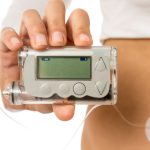Diabetes is a chronic condition and more than 90 per cent of Diabetes care is self- care. Habits are repeated behaviours that can improve self-care practices and can lead to long term good health.
“The habits you repeat (or don’t repeat) every day largely determine your health, wealth, and happiness. Knowing how to change your habits means knowing how to confidently own and manage your days, focus on the behaviours that have the highest impact, and reverse-engineer the life you want.”- James Clear, writer & author, leading expert in habit formation.
If you are passionate about your health and wellness and believe that you play an important role in managing Diabetes, then these simple yet powerful habits will put you in control of your Diabetes.
Why habits matter
“When you learn to transform your habits, you can transform your life”- James Clear. Your daily habits can be small, yet meaningful and crucial for a life well lived with Diabetes.
A habit is a routine of behaviour that is repeated regularly and tends to occur subconsciously. Habit formation is the process by which a behaviour, through regular repetition, becomes automatic or habitual. This process of habit formation can be slow. Lally et al. (2010) found the average time for participants to form a habit was 66 days with a range of 18-254 days.
There are 3 main components to habit formation: the context cue, behavioural repetition and the reward. The context cue is what triggers the habitual behaviour. The behaviour is the actual habit that one exhibits, and the reward, such as improved blood glucose levels, lowered blood pressure or a positive feeling help the person continue to repeat the habit in order to make it more automatic – i.e. it will no longer require a trigger.
An individual is the sum of their habits as they set the pattern of your life. Good habits can enable any person to reach their goals – sticking to an eating plan, exercising regularly. Healthy habits can help us achieve proper weights, keep blood glucoses in range and help lower the risk of Diabetes. Good habits increase quality of life and promote longevity.
5 good habits for all people with Diabetes are highlighted in this article. They are:
-
Regularly monitor your health parameters – blood glucose levels, blood pressure, etc. It is important to know these numbers.
-
A good night’s sleep – qualitative and quantitative sleep is important for blood glucose management.
-
Paying attention to your mental well- being – mental health is as precious as physical health.
-
Eating a Diabetes friendly meal – a balanced nutritious meal is paramount for managing Diabetes.
-
Daily physical activity – exercising daily helps burn calories and lower blood glucose level.
 n
n
-
Know your numbers
“Only what gets measured gets managed”. Diabetes comes with its share of ups and downs but keeping track of important metrics of life such as blood glucose, blood pressure, weight, physical and mental well- being matters.
These are the following ways to test blood glucose levels:
Random blood glucose test requires a blood sample to be taken. Regardless of when you last ate, a reading of 200mg/dL or higher would indicate that you have Diabetes. However, this is not an ideal diagnostic test.
Fasting blood glucose test requires a blood sample to be taken after an 8-12 hour overnight fast. A fasting blood glucose level between 100-125mg/dl indicates Pre-Diabetes, whereas levels >125mg/dL indicates that you have Diabetes.
Postprandial blood glucose test measures blood glucose levels following a meal containing a set amount of carbohydrate. A 2-hour postprandial blood glucose test measures blood glucose exactly 2 hours after eating a meal, timed from the start of the meal. By this point blood glucose has usually gone back down in healthy people, but it may still be elevated in people with Diabetes.
HbA1c or glycated haemoglobin is a test that measures average plasma glucose concentration. HbA1c test (glycated haemoglobin test) is done to assess your blood glucose control over the previous two or three months. The advantage of this test is that it does not require fasting and can be done anytime during the day. A result of 5.7-6.4 per cent denotes Pre-Diabetes and a result of 6.5 per cent or higher indicates Diabetes.
Glucometers offer at home convenience of home blood tests. A glucometer at home is very useful. Whenever you get symptom, that you wish to attribute to high or low sugar, do an immediate glucometer based estimation and that will give a quick approximate guide to your levels.
Continuous Glucose Monitoring System or CGMS is a device that records glucose levels throughout the day and night. It provides up to 288 glucose readings in 24 hours. The system is used to measure average blood glucose for up to 14 days. It involves a tiny, sterile, flexible electrode being inserted just under the skin. A tiny pager-like device shows you the readings every few minutes. These readings give a more accurate picture of how your blood glucose level changes throughout the day, warning you of highs and lows almost immediately.
 n
n
Blood pressure monitoring
Blood pressure monitoring is crucial part of self-care as high blood pressure raises your risk of heart attack, stroke, eye problems and kidney disease. As many as 2 out of 3 adults with Diabetes have high blood pressure.
Blood pressure is the force of blood flow inside your blood vessels. When your health care team checks your blood pressure, they record two numbers, such as 120/80 mmHg. You’ll hear them say this as ‘one- twenty over eighty’. Both numbers are important:
-
The first number is the pressure as your heart beats and pushes blood through the blood vessels. Health care providers call this the ‘systolic’ pressure.
-
The second number is the pressure when the vessels relax between heartbeats. It’s called the ‘diastolic’ pressure.
When your blood moves through your vessels with too much force, you have high blood pressure. Your heart has to work harder when blood pressure is high and your risk for Diabetes problems goes up.
High blood pressure is a problem that won’t go away without treatment. The general guidelines are as under:
-
Normal BP – less than 120/80
-
Pre-hypertension 120 to139/80 to 89
-
High BP (stage 1) 140 to159/90 to 99
-
High BP (stage 2) higher than 160/100
A slight variation to these numbers is quite normal, but very high blood pressure (hypertension) poses health risks such as heart attack, congestive heart failure, stroke, kidney failure, peripheral artery disease and hypertensive retinopathy (eye damage).
Waist circumference
The increased amount of fat around your belly and waist increases your risk of Type 2 Diabetes, high blood pressure, high cholesterol and heart disease. It is advised that waist measurement should not be more than 40 inches for men and 35 inches for women. People with larger waist circumference may require losing weight.
 n
n
2. Get Sleep
This should not come as a surprise! Sleep is like nutrition for the brain. A lot of things can go wrong when we are sleep deprived. Sleep plays an important role in keeping fit and prevents many health conditions.
Disturbed sleep and daytime sleepiness may affect metabolism and may lead to weight gain, irritability, forgetfulness and depression. In rare cases, people may also talk or walk while sleeping and grind their teeth. The Institute of Medicine has declared sleep deficiency and sleep disorders as ‘an unmet public health problem’.
Lack of sleep in the long term increases the risk of-
-
Cognitive disturbances
-
Glucose intolerance and Diabetes
-
Obesity
-
High blood pressure
-
Impaired immunity
-
Plaque build-up on the walls of the arteries
-
Heart disease and stroke
There is a significant overlap between Diabetes, heart disease and sleep disorders.
Insomnia and Diabetes
There is a direct relationship between the quality of sleep and blood glucose control in people with Type 2 Diabetes. Studies have shown that sleep deprivation leads to insulin resistance which leads to high blood glucose levels. If a person does not have a good night’s sleep then glucose is released from the liver. This leads to an increase in the fasting blood glucose level. When insomnia is treated resulting in improved sleep, the person with Diabetes also has better blood glucose level control.
Obstructive sleep apnoea and heart disease risk
People with Obstructive sleep apnoea (OSA) have an increased risk of heart disease and stroke. Low oxygen in the blood caused by an obstruction of airway leads to inflammation, increased heart rate and increased rate of atherosclerosis (narrowing of blood vessels) leads to blockages in the arteries. Adequate and good quality of sleep is essential to reduce the risk of heart disease. In OSA, as our body stores fat, our blood glucose levels and blood pressure increases and as a result there is increased risk of heart disease. It becomes difficult to manage Diabetes in people who have associated severe OSA as this also leads to severe insulin resistance. Sleep study helps diagnose OSA. Treatment of OSA improves wellbeing and is rewarding in long term.
Diabetes and sleep disorders
People with Type 2 Diabetes are at an increased risk of developing sleep disorders. This could be due to associated comorbidities like obesity, hypertension or also could be because of associated complications of Diabetes like heart disease, kidney disease. Certain sleep disorders like OSA, insomnia and restless legs syndrome are diagnosed more frequently in people with Diabetes as compared to those who don’t have Diabetes.
Tips for a good night sleep
Do:
-
Improve sleep hygiene.
-
Relaxing techniques 30 minutes prior to bedtime e.g. listening to light music, meditation etc.
-
Take a warm bath before sleep.
-
Bedtime snacking if you have Diabetes and doctor has advised bedtime snacks to avoid hypoglycaemia at night.
Avoid:
-
Distractions such as smartphones, televisions, computers etc.
-
Thinking about stressful situations
-
Heavy eating, vigorous exercise, smoking
-
Afternoon naps
-
Wake-promoting substances like caffeine 2-3 hours before bedtime
 n
n
3. Proactive wellness
“Success is a journey, not a destination. The doing is often more important than the outcome”-Arthur Ashe
Stress can be physical or mental. It can complicate Diabetes by distracting you from proper care or affecting blood glucose levels directly. Learning to relax and making lifestyle changes can help reduce mental stress. Stress results when something causes your body to behave as if it were under attack. Sources of stress can be physical, like injury or illness. Or they can be mental, like problems in your education, marriage, job, health or finances.
When stress occurs, the body prepares to take action. This preparation is called the fight-or-flight response. In the fight-or-flight response, levels of many hormones shoot up. Their net effect is to make a lot of stored energy – glucose and fat – available to cells. These cells are then primed to help the body get away from danger. In people who have Diabetes, the fight-or-flight response does not work well. Insulin is not always able to let the extra energy into the cells, so glucose piles up in the blood.
 n
n
Chronic stress can completely upset your emotional equilibrium, as well as your physical health. Chronic stress can do real harm to your body, and cause emotional and physical problems, including digestive problems, chest pain, high blood pressure, anxiety, irritability, depression, muscle tension and fatigue.
For people with Diabetes, stress plays a direct role in worsening your health parameters as it raises blood glucose levels and blood pressure levels, activates our fat cells, contributes to insulin resistance and impairs glucose tolerance. Not only does stress hamper your mental wellbeing but it also wreaks havoc with your physical well- being. Many sources of stress are long-term threats. For example, it can take many months to recover from surgery. Stress hormones that are designed to deal with short-term danger stay turned on for a long time. As a result, long-term stress can cause long-term high blood glucose levels. Effective stress management is crucial for continued mental and physical well-being.
Checking in to improve Diabetes on a day to day basis helps to limit long term stress. Do not wait for the symptoms to get worse before you seek guidance. Seeking knowledge about the management, reaching out to nutrition coaches for novel diet therapies, exploring treatment options, investing in regular health assessments display your wellness habit. Focus on thriving and not just surviving.
“Without mental health, there is no true physical health”- Dr Brock Chrisholm, WHO
Rather than feeling burnout with health problems, giving emphasis to what one can control matters the most. Mantra is keeping a positive and a hopeful outlook, staying resilient which helps cope with the condition.
A 2022 study indicated that people with Type 1 Diabetes are more likely to manage their blood condition successfully, if they had high psychological resilience. Resilience refers to a person’s ability to adapt and cope with stressful situations while maintaining or restoring normal functioning. Experts believe that improving resilience is possible that can contribute to health, ease illness and accelerate healing. If we practice resilience we can get better at it. What we repeatedly do becomes a habit.
4. Adopting Diabetes friendly meal habits
Eating a healthy Diabetes diet requires you to eat less of some foods and more of others. In the past, people were handed after their diagnosis with a list of foods they weren’t allowed to eat or often told to simply cut out sugars. Nowadays, you may need to make some changes to your diet, but it’s not a case of cutting things out.
Rather, you’ll need to follow the same healthy, balanced diet that’s recommended to everyone. Your dietician can help you to plan a customised menu by observing your blood glucose levels, body weight and other parameters.
 n
n
How to improve diet?
Pairing your macro nutrients
It is recommended to balance your meal with a mixture of carbohydrates protein and fibres. For example, instead of having plain poha, you can add sprouts (protein) and lots of veggies (fibre) to poha. This can help you reduce the quantity of poha (carbohydrates) in that particular meal. This slows down the process of sugar absorption in your body because the sugars are mixed with other food elements such as fibre and protein.
Eat your protein first and carbohydrates later
Pairing your carbohydrates with protein or consuming protein with non-starchy vegetables can give favourable outcomes Vs consuming only carbohydrate dense foods in your meals. Nutrient sequencing or consuming your meals in an order can help moderate post meal glucose spikes. A 2016 study reported that adding protein and fat macronutrients to glucose in a mixed meal diminished glucose excursion.
Be mindful of carbs and limit carbohydrate intake especially in the evenings. It is well documented that amongst macronutrients, carbohydrates have the highest impact on blood glucose levels. Multiple studies using low carbohydrate dietary intervention to treat Diabetes have documented benefits with respect to weight, insulin, medication reduction and lipoprotein metabolism.
Excess dietary carbohydrates can increase liver fat which in turn increases insulin resistance, making it harder to control Diabetes.
Insulin sensitivity varies during the day with decreased values in evening and night.
Since the body’s ability to process high carb food is diminished later during the day, a simple habit of eating fewer carbohydrates in the evenings can lead to improved glucose profile.
 n
n
Eat more intuitively
Eat when you are hungry and stop when you are full. Meal timings and frequency of meals are as important as the macronutrient composition of your diet for effective Diabetes management. Research shows that meal timing and frequency can have varying responses for people with Diabetes. Whether you follow 3 meal pattern or 6 meal pattern, match your timings and frequency with your hunger cues and your glycaemic targets. Intuitive eating has been associated with glycaemic control in Diabetes. Ensure that you eat your healthy meals at regular intervals on time. Do not skip your meals. Do not keep a gap of more than 3-4 hours in between meals.
Mealtime mindfulness
Mindfulness should be practiced while eating. See, smell, taste and chew the food well. Try to have a variety of foods to make your meal interesting and appealing.
Sometimes it is good to add colour to your food to help you achieve this. Try adding multiple colours in single meal like red pepper and green salad or some pomegranate and grapes, depending on weather and liking of an individual.
Eat high-fibre foods
Eat plenty of high-fibre foods as they tend to have a low glycaemic index. These may help to keep your blood glucose levels from going too high after meals. High-fibre foods include fresh fruit and non-starchy vegetables like green leafy vegetables, beans, salads etc., wholegrain cereals, sprouts and pulses.
Eat five meals a day
Make sure you have at least five portions of fruits and vegetables each day. Add at least 1-2 portions of fruits in a day. You can add it to your breakfast cereals or porridge.
Snack on fruit rather than biscuits or cakes. Choose two vegetables, preferably green leafy vegetable for 4-5 times a week along with your main meal. Add a bowl of salad or soup to your lunch and dinner.
Note: Avoid fruit juices. By extracting juice, we remove all the fibres from the fruits.
That’s why juice can quickly raise your blood glucose. Sometimes, you can dilute fruit juices with water. Use about one quarter juice to three quarters of water and drink once a day. Keep yourself hydrated with water and other drinks without sugar such as fresh lime water, kokum water, buttermilk and vegetable soups etc. Avoid carbonated beverages like cola and canned juices.
Cut down on saturated fats
Use unsaturated fats such as vegetable oil like olive oil or sunflower oil for cooking and salad dressing. Avoid saturated fats like deep fried foods, butter, mayonnaise, margarine and cream. Incorporate healthy cooking methods like grilling, roasting, steaming instead of frying. Snack on nuts and seeds rich in unsaturated fats, instead of biscuits etc. Trim fat from meats.
Moderation is the key
Use a smaller plate to keep an eye on your portion sizes. You can also eat between two and four snacks, including an after-dinner snack to help your blood glucose levels to remain stable. Please consult your dietician as the requirement may vary from person to person.
Cut down on sugary foods and drinks
Cut down or give up sweets, fizzy drinks, fruit juice, desserts and ketchups etc. These foods contain simple sugars that can quickly raise your blood glucose levels. Restrict products prepared from refined carbohydrates
Avoid refined carbs like maida preparations (bread, khari, toast, butter-biscuits etc.). Corn-flour, sago, potato, processed and packaged foods and sauces etc should also be avoided.
 n
n
Just eat real food
Avoid processed and packaged foods. Processed foods are loaded with artificial chemicals including flavourings, colours and preservatives. The more you eat processed foods, the less you will get vitamins, minerals, antioxidants and various trace nutrients.
A dietician will prepare a personalised eating plan that will take into account your weight and other parameters. A dietician will talk to you about carbohydrate counting, when and how much carbohydrate should you consume, timing of insulin and food consumption. Your dietician may make changes to your diet plan based on your blood glucose levels and how much weight you have gained.
You need to follow a diet plan even after you are prescribed insulin.
5. Take a walk, pump those muscles every day
Exercise helps control weight, lower blood pressure, lower harmful LDL cholesterol and triglycerides, raise healthy HDL cholesterol, strengthen muscles and bones, reduce anxiety, and improve your general well-being. There are added benefits for people with Diabetes – exercise lowers blood glucose levels and boosts your body’s sensitivity to insulin, countering insulin resistance.
Glucose is a major fuel source during exercise. Exercise stimulates glucose uptake by as much as 50 times when compared to rest. Since muscles use the available glucose, the body does not have to release too much insulin to bring down blood glucose levels after meal intake. This contributes to improved insulin sensitivity and glycaemic control.
Studies show that:
-
Exercise lowered HbA1c values by 0.7 percentage point in people of different ethnic groups with Diabetes who were taking different medications and following a variety of diets and this improvement occurred even though they didn’t lose any weight.
-
All forms of exercise aerobic, resistance, or doing both (combined training) were equally good at lowering HbA1c values in people with Diabetes.
-
Resistance training and aerobic exercise both helped to lower insulin resistance in previously sedentary older adults with abdominal obesity at risk for Diabetes. Combining the two types of exercise proved more beneficial than doing either one alone.
-
People with Diabetes who walked at least two hours a week were less likely to die of heart disease than their sedentary counter- parts, and those who exercised three to four hours a week cut their risk even more.
-
Women with Diabetes who spent at least four hours a week doing moderate exercise (including walking) or vigorous exercise had a 40 per centlower risk of developing heart disease than those who didn’t exercise. These benefits persisted even after researchers adjusted for confounding factors, including BMI, smoking, and other heart disease risk factors.
 n
n
Talk to your doctor about what kind of exercise is right for you. The type of exercise suitable for you will depend on whether you have any other health problems. Most doctors recommend aerobic exercise, which makes you breathe more deeply and makes your heart work harder. Examples of aerobic exercise include walking, jogging, aerobic dance or bicycling. If you have problems with the nerves in your feet or legs, your doctor may suggest exercise that won’t put too much stress on your feet. These exercises include swimming, bicycling, rowing or chair exercises.
No matter what kind of exercise you do, you should warm up before you start and cool down when you’re done. To warm up, spend 5 to 10 minutes doing a low-intensity exercise such as walking. Then gently stretch for another 5 to 10 minutes. Repeat these steps after exercising to cool down.
When you start an exercise program, remember to go slow. Increase the intensity and length of your workout gradually, as you get fitter. Talk to your doctor for specific advice.
Take a short walk after meals ranging from 2-15 minutes. Little exercise can make a lot of difference to your numbers. Taking a short walk for 2-5 minutes after your meal is a great habit to tame your post meal blood glucose excursions, new research shows. Another study demonstrated moderate intensity brisk walking for 15 minutes after each meal was more beneficial in controlling blood glucose in people with Type 2 Diabetes as compared to routine walk of 45 min at a stretch.
Exercise checklist for people who have Diabetes
-
Discuss with your doctor about the right exercise for you.
-
Monitor your blood glucose level before, during and after exercising.
-
Check your feet for blisters or sores before and after exercising.
-
Wear appropriate shoes and socks.
-
Drink plenty of fluid before, during and after exercising.
-
Warm up before exercising and cool down afterwards.
-
Have a snack handy, in case your blood glucose level drops too low.
Tushima Shali Mashelkar is a Clinical Nutritionist, certified Diabetes Educator and a Habit coach















